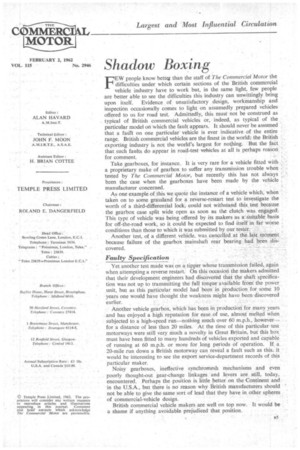Shadow Boxing
Page 39

If you've noticed an error in this article please click here to report it so we can fix it.
FEW people know better than the staff of The Commercial Motor the difficulties under which certain sections of the British commercial vehicle industry have to work but, in the same light, few people are better able to see the difficulties this industry can unwittingly bring upon itself. Evidence of unsatisfactory design, workmanship and inspection occasionally comes to light on assumedly prepared vehicles offered to us for road test. Admittedly, this must not be construed as typical of British commercial vehicles or, indeed, as typical of the particular model on 'which the fault appears. It should never be assumed that a fault on one particular vehicle is ever indicative of the entire range. British commercial vehicles are the finest in the world; the British exporting industry is not the world's largest for nothing. But the fact that such faults do appear in road-test vehicles at all is perhaps reason for comment.
Take gearboxes, for instance. It is very rare for a vehicle fitted with a proprietary make of gearbox to suffer any transmission trouble when , tested by The Commercial Motor, but recently this has not always been the case when the gearboxes have been made by the vehicle manufacturer concerned.
As one example of.this we quote the instance of a vehicle which, when taken on to some grassland for a reverse-restart test to investigate the worth of a third-differential lock, could not withstand this test becauo the gearbox case split wide open as soon as the clutch was engaged. This type of vehicle was being offered by its makers as a suitable basis for off-the-road work, so it could be expected to find itself in far worse , conditions than those to which it was submitted by our tester.
Another test, of a different vehicle, was cancelled at the last moment because failure of the gearbox rnainshaft rear bearing had been discovered.
Faulty Specification
Yet another test made was on a tipper whose transmission failed, again when attempting a reverse restart. On this occasion the makers admitted that their development engineers had discovered that the shift specification was not up to transmitting the full torque available from the power., unit, but as this particular model had been in production for some 10 years one would have thought the weakness might have been discovered earlier.
Another vehicle gearbox, which has been in production for many years and has enjoyed a high reputation for ease of use, almost melted when subjected to a high-speed run—nothing much over 60 m.p.h., however— for a distance of less than 20 miles. At the time of this particular test motorways were still very Much a novelty in Great Britain, but this box must have been fitted to many hundreds of vehicles exported and capable of running at 60 m.p.h. or more for long periods of operation. If, a 20-mile run down a British motorway can reveal a fault such as this, it • would be interesting to see the export service-department records of this particular mak cr.
Noisy gearboxes, ineffective synchromesh mechanisms and even poorly thought-out gear-change linkages and levers are still, today, encountered. Perhaps the position is little better on the Continent and in the U.S.A., but there is no reason why British manufacturers should • not be able to give the same sort of lead that they have in_ other spheres of commercial-vehicle design.
British commercial vehicle makers are well on top now. It would be a shame if anything avoidable prejudiced that position.




























































































































